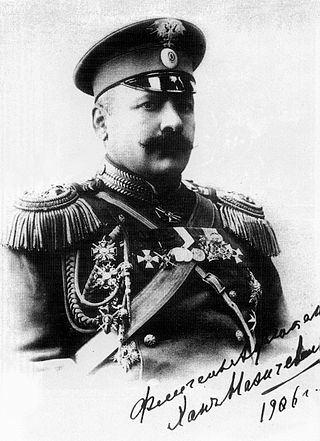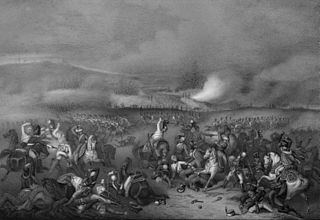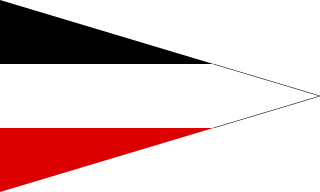
The Russian Imperial Guard, officially known as the Leib Guard were military units serving as personal guards of the Emperor of Russia. Peter the Great founded the first such units in 1683, to replace the politically motivated Streltsy. The Imperial Guard subsequently increased in size and diversity to become an elite corps of all branches within the Imperial Army rather than Household troops in direct attendance on the Tsar. Numerous links were however maintained with the Imperial family and the bulk of the regiments of the Imperial Guard were stationed in and around Saint Petersburg in peacetime. The Imperial Guard was disbanded in 1917 following the Russian Revolution.

The Preobrazhensky Life-Guards Regiment was a regiment of the Imperial Guard of the Imperial Russian Army from 1683 to 1917.

Huseyn Khan Nakhchivanski, or Nakhichevansky, francised spelling: Hussein Nahitchevansky, was a Russian Cavalry General of Azerbaijani origin. He was the only Muslim to serve as General Adjutant of the H. I. M. Retinue.

The Chevalier Guard Regiment was a Russian heavy cavalry guard regiment, created in 1800 by the reformation of the Chevalier Guard corps, itself created in 1764 by Catherine the Great. As other Russian heavy cavalry guard regiments, the Chevalier Guards were equipped as cuirassiers.
The Imperial Russian Army in June 1812 consisted of three main armies and other military formations. The Commander in Chief of the Army was Emperor Alexander I.

The Guards Cavalry Division (Garde-Kavallerie-Division) was a unit of the Prussian Army that was stationed in Berlin. The division was a part of the Guards Corps (Gardekorps).
The Household Cavalry Composite Regiment was a temporary, wartime-only, cavalry regiment of the British Army consisting of personnel drawn from the 1st Life Guards, 2nd Life Guards and Royal Horse Guards. It was active in 1882 for service in the Anglo-Egyptian War, in 1889–1900 during the Second Boer War, from August to November, 1914 during the opening months of World War I and in World War II.

The 3rd Cavalry Division was a division of the British Army in the First World War. It was formed at Ludgershall, Wiltshire England in September 1914 under the command of Major-General the Hon. Julian Byng. The division moved to Belgium in the first week of October 1914, landing at Ostend, although its third Brigade was only formed there once. During the war the division took part in most of the major actions where cavalry were used as a mounted mobile force, and also many where the troops were dismounted and effectively served as infantry.
The 3rd Army Corps was an Army corps in the Imperial Russian Army formed on 19 February 1877.
The 1st Guards Infantry Division was an infantry formation of the Russian Imperial Army which was part of the Imperial Guard. It was headquartered in Saint Petersburg and was part of the Guards Corps. It took part in fighting against Napoleonic invasion of Russia in 1811 shortly after its formation. It was expanded in July 1914 upon the mobilization of the Russian Imperial Army, and took part in fighting on the Eastern Front of World War I. The division was demobilized in 1918 after the Russian Revolution.
The 1st Guards Cavalry Division was a Guards heavy cavalry division of the Imperial Russian Army.

The 2nd Cavalry Division was a unit of the German Army in World War I. The division was formed on the mobilization of the German Army in August 1914. The division was disbanded in 1919 during the demobilization of the German Army after World War I.
The history of the German Cavalry in World War I is one of an arm in decline.
The 1st Cavalry Brigade was a brigade of the British Army. It served in the Napoleonic Wars, the Anglo-Egyptian War, the Boer War and in the First World War when it was assigned to the 1st Cavalry Division.
The 7th Cavalry Brigade was a cavalry brigade of the British Army. It served in the Napoleonic Wars, notably at the Battle of Waterloo. It was reformed in 1914 and served on the Western Front as part of the 3rd Cavalry Division until the end of World War I.
The Secunderabad Cavalry Brigade was a cavalry brigade of the British Indian Army formed in 1907 as a result of the Kitchener Reforms. It was mobilized as 9th (Secunderabad) Cavalry Brigade at the outbreak of the First World War and departed for France. It served on the Western Front as part of the 1st and 2nd Indian Cavalry Divisions until it was broken up in March 1918.
The 1st Cavalry Division was a cavalry formation of the Russian Imperial Army.
The Caucasus Cavalry Division was a cavalry formation of the Russian Imperial Army.
The 1st Guards Corps was a corps-level command in the Russian Imperial Army that existed in the decades leading up to and during World War I. Stationed in St Petersburg, it included some of the oldest and best known regiments of the Emperor of All Russia's Imperial Guard.

His Majesty's Life Guards Hussar Regiment was a Guards Hussar regiment of the Army of the Russian Empire.






